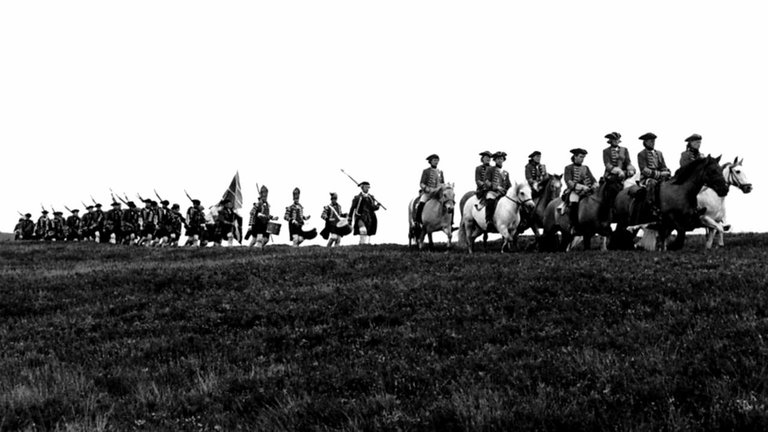
The BBC has established itself as a paragon of excellence in television, renowned for its pioneering contributions to the medium and its willingness to innovate in ways that many commercial networks have shied away from. This esteemed reputation has been built upon the efforts of a multitude of talented individuals who have consistently provided high-quality content. Among these luminaries is director Peter Watkins, whose feature debut, the 1964 television film Culloden, stands as one of the finest docudramas in the annals of both cinema and television.
Culloden is adapted from John Prebble's eponymous 1961 book. Prebble, celebrated for his historical writings, also wrote the screenplay for Zulu, another significant British war film released in the same year as Culloden.
The film is dedicated to the last major land battle fought on British soil, marking a significant chapter in the history of the British Isles. This battle represents the culmination of the Jacobite uprising, which began in 1745 when Charles Edward Stuart—commonly known as "Bonnie Prince Charlie"—landed in Scotland with aspirations to restore the Stuart dynasty to the throne and displace King George II of the Hanoverian dynasty. The grandson of James II/VI, who was deposed during the Glorious Revolution of 1688, Charlie's campaign initially saw success as Jacobite forces captured large swathes of Scotland. However, they ultimately failed to capitalize on these victories. The British government, preoccupied with the War of Austrian Succession in Europe, reorganised its forces and dispatched a well-trained army led by Prince William Augustus, Duke of Cumberland. On April 16th, 1746, this force confronted Bonnie Prince Charlie’s army at Culloden, near Inverness—city that had become the key stronghold for Jacobite supporters.
The plot of Culloden meticulously depicts the battle and its immediate aftermath. What distinguishes this film from many historical epics of its time is its unconventional style; it presents the battle as a quasi-documentary, akin to a contemporary television news report recorded two centuries earlier. The narrative is delivered through an omniscient voiceover that provides exposition and context while elucidating the tactical dynamics on the battlefield. Furthermore, historical figures and ordinary soldiers are given a voice through fictional interviews conducted by an interviewer, creating an engaging interplay between past and present.
While this approach may not have been entirely original—CBS Television had previously aired You Are There, an educational series that reconstructed historical events through fictional news reports—the execution in Culloden is notably more ambitious. Watkins extends this format with an intense focus on authenticity. Rather than relying on studio sets, he filmed on location around Culloden and Inverness, investing considerable effort into ensuring that costumes, weaponry, and other details accurately reflected the period. A crucial aspect of this authenticity was employing non-professional actors who physically embodied 18th-century individuals; many were deliberately cast to appear unkempt or weathered, reflecting the era's harsh realities regarding health and hygiene.
This unvarnished portrayal serves not only an aesthetic purpose but also embodies Watkins' own unromantic perspective on history. He eschews both British nationalist glorification of victory—which heralded a united empire—and Scottish nationalist nostalgia for a lost cause. Instead, Watkins presents the battle as a brutal and tragic event marked by fratricide; many soldiers on both sides were motivated by tribal loyalties rather than ideological convictions regarding dynastic politics or religious differences. The film illustrates how these men were often compelled to fight due to feudal obligations rather than fervent beliefs in their respective causes.
Despite operating on a relatively modest budget, Watkins maximised his resources effectively. The film's limited number of extras and reliance on just one cannon did not detract from its visual impact; rather, it was achieved through an emphasis on intensity and realism. The battle scenes are strikingly violent by 1960s television standards yet manage to evade censorship largely due to their black-and-white presentation and lack of explicit bloodshed. The violence depicted extends beyond combat; it also portrays the aftermath where British troops ruthlessly pursue fleeing Jacobites into the mountains, mercilessly attacking both men and women.
This grim depiction of such a pivotal event in British history aligns with Watkins’ leftist and pacifist ideologies—views that would continue to inform his later works. His subsequent quasi-documentary film War Game, which explored hypothetical nuclear conflict, faced controversy and was banned by the BBC shortly after its release due to its stark portrayal of war.
In essence, Culloden is crafted with limited resources yet abundant skill and creativity. Despite its brief runtime mirroring that of the actual battle it depicts, it functions as a historical epic in its own right. The film has rightfully earned its status as a classic within television docudramas due to its innovative approach and profound thematic exploration.
RATING: 9/10 (++++)
Blog in Croatian https://draxblog.com
Blog in English https://draxreview.wordpress.com/
InLeo blog https://inleo.io/@drax.leo
Hiveonboard: https://hiveonboard.com?ref=drax
InLeo: https://inleo.io/signup?referral=drax.leo
Rising Star game: https://www.risingstargame.com?referrer=drax
1Inch: https://1inch.exchange/#/r/0x83823d8CCB74F828148258BB4457642124b1328e
BTC donations: 1EWxiMiP6iiG9rger3NuUSd6HByaxQWafG
ETH donations: 0xB305F144323b99e6f8b1d66f5D7DE78B498C32A7
BCH donations: qpvxw0jax79lhmvlgcldkzpqanf03r9cjv8y6gtmk9
Posted Using INLEO